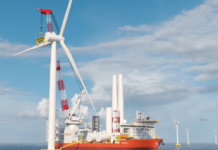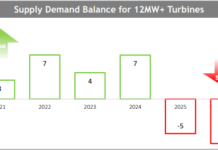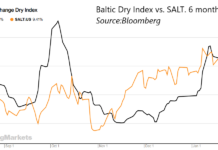Even though solar – and especially solar PV – has managed to capture the lion’s share of public equity investors’ attention over the past three years, wind remains far more competitive with with fossil-fired power generation on a cost basis than solar, and thus presents a fundamentally stronger investment case for the time being (and I emphasize for the time being). What’s more, wind as an industry is more mature than solar; for solar, the lack of earnings for many companies and the wildly inflated PEs for others make the sector potentially volatile and risky for investors. While installing a kW of commercial wind in 2007 in the US would have cost you on average $2,200 according to the DOE’s EERE (PDF document), installing the same amount of commercial solar PV would have set you back more than twice that amount. In 2007, the cumulative-capacity-weighted-average wind power price (the amount wind farm owners were paid for their electricity on average) was below the nationwide price band for a flat block of wholesale power. It is therefore not a surprise that, for 2007, the US installed 27% of all global wind (5,329 MW), 62% more than number two China. In fact, between 2004 and 2007, US wind installations were on a tear with a CAGR of 35%, making the US the number one global wind hotspot for that period. 
As can be noted from the graph above (the y-axis is MW), the steepening of the curve has corresponded with a period of uninterrupted Production Tax Credit (PTC) availability. The PTC is a federal incentive for wind power that comes in the form of a tax break per kWh of electricity produced, and has historically been responsible for driving growth in the industry. In fact, the past cycle of PTC expirations and renewals led to a boom-and-bust cycle in US wind, as can be seen from the graph for the period 1999 to 2004. Is PTC The Whole Story? The PTC is set to expire again at the end of 2008 for the first time since October 2004, and the Senate currently appears to be in no mood for an early renewal. Needless to say, this is causing headaches in some quarters. Throw on top of that an inflationary environment for power plant capital costs (tune in later this week for a piece on this) and a credit crisis that’s raising the cost of capital, and you’ve got something like a perfect storm brewing for US wind in 2009. Could the party be about to go on hold? Not so fast. Another phenomenon has been impacting the US wind sector over the past four years that can undoubtedly explain some of the growth: an explosion in state Renewable Portfolio Standards (RPSs). RPSs are state targets for renewable power that are made into legal obligations and often include a penalty for non-compliance – the stick instead of the carrot. 
As can be seen from this table, about 58% of US states currently have a formal RPS, and another 8% have a target. Of those, 76% have either enacted or amended (generally to increase it) their RPS or target on or after 2004. The result is that 63% of US installed capacity now sits in a state with an RPS or target, as does 71% of the population. What Has Really Been Driving Growth? While keeping the PTC alive all this time certainly accounted for much of the growth since 2004, the proliferation of RPSs cannot be ignored. RPSs enshrine renewable energy targets into law, thereby providing powerful drivers for growth. Want to know how powerful? You can try come up with your own rough estimate for any state you’re interested in. Take the EIA’s most recent statistics on installed generation capacity by state (the most recent available year is 2006), grow the state’s installed capacity at a rate you find reasonable (e.g. 2% annually or or use an existing forecast if you can find a good one) until the final year of the RPS, and simply apply the RPS target – which is typically expressed as percentage of total installed capacity by a target year – to your final figure. Multiply that amount by a safety margin of something like 0.7 just to be conservative, subtract what’s already installed, and you may have a rough idea of how much incremental wind a state will install by it’s RPS’ deadline. Of course, certain states will favor solar for physical reasons, while others have technology targets (e.g. NJ wants 2.5% of solar as part of its 22.5% 2021 RPS). It’s up to you to dig a bit deeper to ascertain the particularities of each RPS and what they mean for wind. I conducted such a an analysis for all US states, and while I won’t share my numbers because they are very rough estimates and I don’t want them quoted, I can nonetheless say that some states will experience very solid growth over the next few years. One example is NY, which will install several thousand MW of wind between now and 2015 although it barely registers right now. What’s the takeaway from all this? There was a time during which the PTC drove the vast majority of wind development in the US, and if it went so did the industry. But over the past four years a growing number of states have adopted formal renewable power targets in the form of RPSs, and those will play an increasingly larger role in fostering growth, especially as wind becomes competitive without the PTC. The Year Ahead 2009 could indeed be a bit rough for wind if the PTC isn’t renewed prior to Dec. 31, 2008. Financing costs could become an issue in the midst of ongoing problems in capital markets, so no PTC could compound this. I don’t think, however, that a short-lived slowdown would be a bad thing for the industry. The wind supply chain remains as tight as ever, and a slowing of demand while new manufacturing capacity continues to be added across the US could set the stage for a resumption of strong growth in 2010. In fact, the current uptick in construction of wind manufacturing facilities in many parts of the US can probably be attributed to the proliferation of state RPSs, and is the strongest indicator yet that the industry sees a life for itself beyond the PTC. Wind For US Investors One of the main complaints US investors have with regards to wind is the lack of wind plays available on US exchanges. Like the industry’s dependence on the PTC, this, too, is changing. For one thing, two new wind ETFs have launched in the past few weeks: the First Trust ISE Global Wind Energy Index Fund (FAN) and the PowerShares Global Wind Energy Portfolio (PWND). ETFs are a good way to access a broad basket of pure-play stocks, and thus provide both focused exposure and some risk mitigation through diversification. Moreover, a quick look through our Stocks page will yield several potential picks. A majority of Pink Sheets-listed stocks you will find there under the category Wind are stocks of global wind pure-plays with legitimate listings on exchanges in their home countries (mostly in Europe). In the US, GE (NYSE:GE) retains the largest market share for wind turbines (although competition is stiffening to be sure), and GE Energy Financial Services is active in wind park ownership. FPL (NYSE:FPL), through its FPL Energy unit, is the second largest wind park owner in the world and another way to get exposure to US wind. In both cases, however, it also me
ans you have to buy the rest of the business, which may or may not be of interest. On the more speculative side, investor favorite American Superconductor (NASDAQ:AMSC) remains a play of choice for many, although valuation is a definite concern for me. Although top line has been expanding rapidly on the back of strong growth in China, I feel much of the stock’s potential is already priced in. My favorite way to play this would therefore be thorough one of the two ETFs, although I haven’t looked at them in enough detail yet to say which I prefer (this is something I intend to write about soon). Keep an eye out for what is happening on the PTC front, and for signs that the ETFs’ prices are trending down as a result. When to pull the trigger is up to you, but based on what I wrote above you can rest assured that, PTC or not, US wind will continue to exhibit strong growth in the decade ahead, and the prices of stocks should follow earnings on the way up. DISCLOSURE: The author does have not a position in any of the securities discussed in this article DISCLAIMER: I am not a registered investment advisor. The information and trades that I provide here are for informational purposes only and are not a solicitation to buy or sell any of these securities. Investing involves substantial risk and you should evaluate your own risk levels before you make any investment. Past results are not an indication of future performance. Please take the time to read the full disclaimer here.








Can you confirm that Oregon, California and Nebraska have RPSs? Also, do you know specific Private Equity Firms that are focused on wind power? Am assisting a small LLC that identifies, prepares and connects proven sites to existing power grids for sale to electric utilities. They’ve funded to date by exhausting personal, family and friend resources. We are looking to help with investor debt or equity or combo of both.
Need between $1-$2 Million.
Thanks,
Joe Feig
Joe:
You can find a list of state RPSs with descriptions here:
http://www.dsireusa.org/
With regards to PE/VC space, I can’t claim to be a specialist, so I would rather not put any names forward.
I received the following email from a reader:
“I was just reading your article on future prospects of wind in the US. I was wondering if there is any way I could see the figures discussed under the section relating to RPS’s in America (the figures which show the difference between required and existing capacity). I am only interested for personal reasons, and would not quote or use the figures for anything aside from personal interest.”
I prefer not to share my numbers because they are rough estimates, and also because they required me to come up with a number of assumptions that people may find debatable (assumptions often are).
Using the methodology I outlined and the data I linked to from the EIA, you should be able to reproduce this analysis fairly easily.
Again, it is up to you to dig a bit deeper and find out how each state intends to manage its RPS.